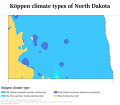The North Dakota Portal North Dakota ( /dəˈkoʊtə/ də-KOH-tə) is a landlocked U.S. state in the Upper Midwest, named after the indigenous Dakota Sioux. It is bordered by the Canadian provinces of Saskatchewan and Manitoba to the north and by the U.S. states of Minnesota to the east, South Dakota to the south, and Montana to the west. North Dakota is part of the Great Plains region, characterized by broad prairies, steppe, temperate savanna, badlands, and farmland. North Dakota is the 19th-largest state, but with a population of less than 780,000, it is the fourth-least populous and fourth-most sparsely populated. The state capital is Bismarck while the most populous city is Fargo, which accounts for nearly a fifth of the state's population; both cities are among the fastest-growing in the U.S., although half of all residents live in rural areas. What is now North Dakota was inhabited for thousands of years by various Native American tribes, including the Mandan, Hidatsa, and Arikara along the Missouri River; the Ojibwe and Cree in the northeast; and several Sioux groups (the Nakota, Dakota, and Lakota) across the rest of the state. European explorers and traders first arrived in the early 18th century, mostly in pursuit of lucrative furs. The United States acquired the region in the early 19th century, gradually settling it amid growing resistance by increasingly displaced natives. The Dakota Territory, established in 1861, became central to American pioneers, with the Homestead Act of 1862 precipitating significant population growth and development. The traditional fur trade declined in favor of farming, particularly of wheat. The subsequent Dakota Boom from 1878 to 1886 saw giant farms stretched across the rolling prairies, with the territory becoming a regional economic power. The Northern Pacific and Great Northern railway companies competed for access to lucrative grain centers; farmers banded together in political and socioeconomic alliances that were core to the broader Populist Movement of the Midwest. North and South Dakota were admitted to the Union on November 2, 1889, as the 39th and 40th states. President Benjamin Harrison shuffled the statehood papers before signing them so that no one could tell which became a state first; consequently, the two states are officially numbered in alphabetical order. Statehood marked the gradual winding-down of the pioneer period, with the state fully settled by around 1920. Subsequent decades saw a rise in radical agrarian movements and economic cooperatives, of which one legacy is the Bank of North Dakota, the only state-run bank in the U.S. (Full article...) Selected article -Abortion in North Dakota is technically legal, but with no current providers. The state's sole abortion clinic, the Red River Women's Clinic, relocated to Minnesota. Following the United States Supreme Court's landmark ruling to overturn Roe v. Wade on June 24, 2022, the state's trigger law, HB 1466, was blocked by the district court, which was upheld by the North Dakota Supreme Court. SB 2150 was passed in response to this, making performance of an abortion is a Class C felony subject to a maximum penalty of five years' imprisonment, a $10,000 fine, or both. The law provides exceptions for medical necessity, or rape or incest when performed before 6 weeks, or if an individual assisting was unaware they were assisting an illegal abortion. In 2024, Judge Bruce Romanick overturned the state's abortion ban. (Full article...) CategoriesGeneral images -The following are images from various North Dakota-related articles on Wikipedia.
Did you know -
TopicsLargest cities
Recognized content
|
- ^ "City and Town Population Totals: 2010-2019". United States Census Bureau. Retrieved May 28, 2020.
- ^ "2010 Census Redistricting Data (Public Law 94-171) Summary File". American FactFinder2. U.S. Census Bureau, 2010 Census. Retrieved October 26, 2012.[dead link]





















